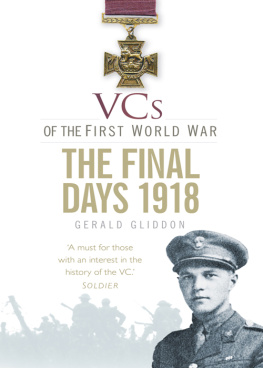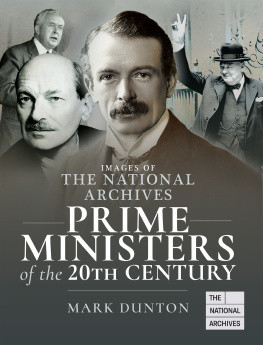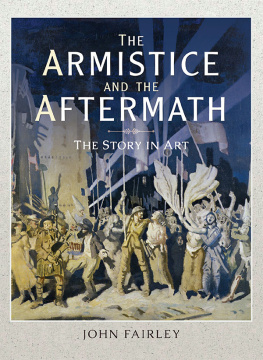IMAGES OF THE NATIONAL ARCHIVES
ARMISTICE
This book is dedicated to the men and women who endured the war. It is for those who gave their lives for it, and for those who had to live with what they experienced. It is for everyone who lost someone in the war. Their name liveth for evermore.
IMAGES OF THE NATIONAL ARCHIVES
ARMISTICE
LOUISE BELL
First published in Great Britain in 2018 by
Pen & Sword History
An imprint of
Pen & Sword Books Ltd
Yorkshire - Philadelphia
Copyright Louise Bell, 2018
ISBN 978 1 52672 941 5
eISBN 978 1 52672 942 2
Mobi ISBN 978 1 52672 943 9
The right of Louise Bell to be identified as Author of this work has been asserted by her in accordance with the Copyright, Designs and Patents Act 1988.
The National Archives logo device is a trade mark of
The National Archives and is used under licence.
The National Archives logo Crown Copyright 2018 Crown Copyright images reproduced by permission of The National Archives, London England, 2018.
The National Archives is the official archives and publisher for the UK Government, and for England and Wales. We work to bring together and secure the future of the public record, both digital and physical, for future generations.
The National Archives is open to all, offering a range of activities and spaces to enjoy, as well as our reading rooms for research. Many of our most popular records are also available online.
A CIP catalogue record for this book is available from the British Library.
All rights reserved. No part of this book may be reproduced or transmitted in any form or by any means, electronic or mechanical including photocopying, recording or by any information storage and retrieval system, without permission from the Publisher in writing.
Pen & Sword Books Ltd incorporates the Imprints of Pen & Sword Books Archaeology, Atlas, Aviation, Battleground, Discovery, Family History, History, Maritime, Military, Naval, Politics, Railways, Select, Transport, True Crime, Fiction, Frontline Books, Leo Cooper, Praetorian Press, Seaforth Publishing, Wharncliffe and White Owl.
For a complete list of Pen & Sword titles please contact
PEN & SWORD BOOKS LIMITED
47 Church Street, Barnsley, South Yorkshire, S70 2AS, England
E-mail:
Website: www.pen-and-sword.co.uk
or
PEN AND SWORD BOOKS
1950 Lawrence Rd, Havertown, PA 19083, USA
E-mail:
INTRODUCTION
At 11am on 11 November 1918, the fighting on the Western Front ceased. It is on this day and this time that Remembrance celebrations take place every year, as we remember the cost of the First World War, and subsequent conflicts. The events leading up to this, both in 1918 and everything back to 1914, had made a great impact. Towns and cities, especially in France and Belgium, were destroyed; many men had lost their lives; and many more returned from the front lines injured or disabled. The effects and aftermath of this war would be experienced for a long time. Even now, 100 years later, the First World War still holds relevance. A two minutes silence is held every 11 November to mark the Armistice; the Cenotaph and the grave of the Unknown Warrior are prominent symbols in British remembrance. International relationships were shaped and changed by this conflict, just as the boundaries and territories of countries did, and the cartography of Europe was remapped.
Buckingham Palace, Peace Celebrations 1919. WORK 36/82
With the Russians having left the war, the Germans were able to free up more men for use elsewhere. The Treaty of Brest-Litovsk was signed on 3 March 1918, between the new Bolshevik government of Russia and the powers of Germany, Austria-Hungary, Bulgaria, and the Ottoman Empire. The Treaty was agreed upon in order to stop German and Austro-Hungarian forces from making further advances into Russia. The Treaty was a harsh one, depriving Russia of 18 provinces and nearly 30 per cent of its pre-war population. It would later be used against the Germans, when they complained that the Treaty of Versailles was too harsh on them.
The Kaiser, Hindenburg and Ludendorff returning from the Western Front at Charleroi station, 1918. RAIL 1020/14
The 1918 Spring Offensive, or Kaiserschlacht , was a series of German attacks along the Western Front, beginning on 21 March and ending on 18 July. Essentially, Ludendorff wanted to try and break the line held by the British, before the full force of the American troops being sent over could join them. Tactically, the Germans gained a lot of ground in the first of the Offensives and captured numerous prisoners. Throughout this time, the German and Allied forces lost almost equal numbers of men, whether through injury or death. The early success of the offensive gave way to the biggest weakness the Germans were too exhausted to sustain this level of attack, and their transport was not good enough to get the necessary supplies. They struggled to move both men and guns across the Western Front. The British were badly hurt in this period, but not broken, as the Germans would have wished. Co-ordination in command and operations greatly improved after this, and then came the arrival of the Americans, adding to the number of Allied troops.
1918 saw what came to be known as the Hundred Days Offensive. This was a series of battles which took place on the Western Front between August and November of that year. Following the Allied attacks at the Second Battle of the Marne, from 15 July until 6 August, the British, American, French and Belgian armies mounted a series of their own offensive operations. These would ultimately drive back the Germans from the great gains that they had made during the Spring Offensive, and eventually force the German government to see and agree to peace. On 8 August, General Rawlinsons Fourth Army launched a major attack at Amiens. The Fourth Army had almost doubled in size for the lead up to this, with help from Canadian, Australian and American corps. The battle that followed highlighted how the Allied forces had learned how to successfully combine infantry, artillery, aircraft and tanks into a co-ordinated attack. Attacks made on the Hindenburg Line in September proved successful, and on the 26th, they broke through it. From this point onwards, fighting was still vicious, but the Germans were being pushed further back, until they were forced to accept the terms of peace and the Armistice.
Early on the morning of 8 November, the German Armistice Commission arrived in the small station in the forest of Compiegne. These men had been hurriedly put together, after the Germans had received a letter from Woodrow Wilson stating that he was willing to make peace. Among its 34 clauses, the Armistice contained some major points relating to termination of hostilities on the Western Front within 6 hours of the agreement being signed: the evacuation of occupied France, Belgium, and Alsace-Lorraine within 15 days; and the surrender of machine guns, aircraft, rolling stock, and military stores. As we know, the Armistice came into effect at 11am the same morning.











